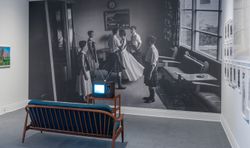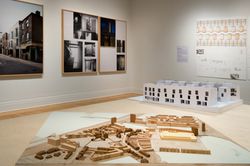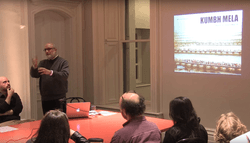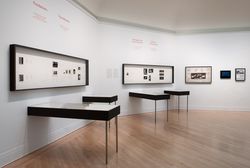In an age of unprecedented human impact on the planet, certain countries stand out for their privileged positions and the complexity of their relationships with the land. Stories about Canada closely follow the discovery and appropriation of vast and varied natural resources as well as changing ideas of the proper relationship between people and their environment.(...)
16 November 2016 to 9 April 2017
It’s All Happening So Fast
Actions:
Description:
In an age of unprecedented human impact on the planet, certain countries stand out for their privileged positions and the complexity of their relationships with the land. Stories about Canada closely follow the discovery and appropriation of vast and varied natural resources as well as changing ideas of the proper relationship between people and their environment.(...)
Wolfgang Ernst, chair of media theories at Humboldt University in Berlin, introduces media archaeology as a method of research and discusses recent concepts of the dynamic archive. He expresses the need for a virtual museum of computer architecture and addresses the concept of the so-called digital humanities, with special attention to the sound-related epistemology(...)
Paul-Desmarais Theatre
25 September 2014 , 6pm
Digital Media Archaeology: Archive, Museum and Sonicity
Actions:
Description:
Wolfgang Ernst, chair of media theories at Humboldt University in Berlin, introduces media archaeology as a method of research and discusses recent concepts of the dynamic archive. He expresses the need for a virtual museum of computer architecture and addresses the concept of the so-called digital humanities, with special attention to the sound-related epistemology(...)
Paul-Desmarais Theatre
As part of the CCA’s ongoing exploration of key issues in contemporary architecture with a specific focus on urban, social, and environmental concerns, Some Ideas on Living in London and Tokyo by Stephen Taylor and Ryue Nishizawa features recent architectural projects that propose new solutions to the challenges of building homes in dense urban environments. London and(...)
Main galleries
14 May 2008 to 26 October 2008
Some Ideas on Living in London and Tokyo by Stephen Taylor and Ryue Nishizawa
Actions:
Description:
As part of the CCA’s ongoing exploration of key issues in contemporary architecture with a specific focus on urban, social, and environmental concerns, Some Ideas on Living in London and Tokyo by Stephen Taylor and Ryue Nishizawa features recent architectural projects that propose new solutions to the challenges of building homes in dense urban environments. London and(...)
Main galleries
Ephemeral landscapes and pop-up settlements are continually increasing in scale and challenging the concept of the city as a stable and permanent entity. For this lecture Rahul Mehrotra, principal of architecture firm RMA Architects and Chair of Urban Planning and Design at the Harvard Graduate School of Design, presents his research on a pop-up settlement called the(...)
Shaughnessy House
13 February 2013 to 12 February 2013
Rahul Mehrota: The Case of the Kumbh Mela in India
Actions:
Description:
Ephemeral landscapes and pop-up settlements are continually increasing in scale and challenging the concept of the city as a stable and permanent entity. For this lecture Rahul Mehrotra, principal of architecture firm RMA Architects and Chair of Urban Planning and Design at the Harvard Graduate School of Design, presents his research on a pop-up settlement called the(...)
Shaughnessy House
After a period of decline, the architectural model gained new prominence when it became a popular tool for design education and practice in the early twentieth century. This revival is usually associated with the turn towards objectivity and the search for expressive means to communicate ideas in three dimensions—but how was the model transformed in the age of its(...)
Octagonal gallery
22 September 2011 to 8 January 2012
Modernism in Miniature: Points of View
Actions:
Description:
After a period of decline, the architectural model gained new prominence when it became a popular tool for design education and practice in the early twentieth century. This revival is usually associated with the turn towards objectivity and the search for expressive means to communicate ideas in three dimensions—but how was the model transformed in the age of its(...)
Octagonal gallery
Series
AP170.S1
Description:
Series 1, Design, prototypes, and related documentation, 1996 - 2006, documents the conceptualization, design, and testing of the HypoSurface project. This includes approximately 2,200 digital design files, a three-square metre Hyposurface wall module, 44 prototype pieces, and a small amount of textual documentation. The digital files in this series contain the bulk of the documentation on the conceptualization and design of the Hyposurface project. Much of this material is richly visual, including still and video concept renderings; images, animations, and drawings of related projects like HypoStage, HypoFloor, HypoFlex, and HypoVoxel; and drawings for prototype “squids” (actuators with rubber covering). The digital files also include material that is more textual in nature, particularly the administrative files for the project, a technical dossier, as well as patent documentation (relating to the physical textual documentation).Notably, the digital materials also include interactive software, called the Aegis Simulator, which allows the user to interact with a rendering of the HypoSurface wall, mimicking the wall’s real-life behavior. Digital formats in this series reflect the range of CAD, still image, and textual documentation present. Notably, there are a significant number of CAD formats present, including AutoCAD, 3DM, DIFF, and IGES formats, consisting of almost 400 total files. The physical component of this series contains a functional three-square metre HypoSurface wall module, as well as 44 other assorted prototype pieces. The prototypes include eight surface pieces in both metal and rubber, two sample actuators, and thirty-four smaller, miscellaneous pieces.
1996 - 2012
Design, prototypes, and related documentation
Actions:
AP170.S1
Description:
Series 1, Design, prototypes, and related documentation, 1996 - 2006, documents the conceptualization, design, and testing of the HypoSurface project. This includes approximately 2,200 digital design files, a three-square metre Hyposurface wall module, 44 prototype pieces, and a small amount of textual documentation. The digital files in this series contain the bulk of the documentation on the conceptualization and design of the Hyposurface project. Much of this material is richly visual, including still and video concept renderings; images, animations, and drawings of related projects like HypoStage, HypoFloor, HypoFlex, and HypoVoxel; and drawings for prototype “squids” (actuators with rubber covering). The digital files also include material that is more textual in nature, particularly the administrative files for the project, a technical dossier, as well as patent documentation (relating to the physical textual documentation).Notably, the digital materials also include interactive software, called the Aegis Simulator, which allows the user to interact with a rendering of the HypoSurface wall, mimicking the wall’s real-life behavior. Digital formats in this series reflect the range of CAD, still image, and textual documentation present. Notably, there are a significant number of CAD formats present, including AutoCAD, 3DM, DIFF, and IGES formats, consisting of almost 400 total files. The physical component of this series contains a functional three-square metre HypoSurface wall module, as well as 44 other assorted prototype pieces. The prototypes include eight surface pieces in both metal and rubber, two sample actuators, and thirty-four smaller, miscellaneous pieces.
Series
1996 - 2012
Project
Steel House
AP144.S2.D60
Description:
File documents an unsuccessful competition entry, in collaboration with Miles Park, Douglas Smith and Frank Newby, for a mass-produced housing system using steel, for a competition sponsored by the European Coal and Steel Community. Requirements called for rapid assembly/disassembly, and flexible unit plans that could be altered by home owners and appeal to a wide range of owners and their preferences. Schematic sketches include exterior elevations, floor plans, preliminary details, and charts for building components. Conceptual sketches show alternate unit and floor plan arrangements, and include network analysis plans, site maximization plans based on transportability, family breakdown diagrams, alternate internal unit layout plans based on age and other factors, functional area plans indicating separation possibilities, and charts which cross-reference factors such as transportability, construction, and assembly requirements. Design development drawings show typical plans, site plans, sections, elevations, details, axonometric drawings of structure and cladding, internal units, and components. Some material in this file was published in Price, Cedric, "Steel Housing", 'Architectural Design', vol. 37, (May 1967) 244, and Price, Cedric, 'Cedric Price-Works II' (London: Architectural Press, 1984) 36, 49-50, 113. Material in this file was produced between 1965 and 1969. 'High Authority of the European Coal and Steel Community' is the full name of the client as found in the textual records. The title of the competition is 'International Competition for the Design of Industrially Fabricated Dwellings'. File contains conceptual drawings, design development drawings, photographic material, presentation panels, textual records, and model.
1965-1969
Steel House
Actions:
AP144.S2.D60
Description:
File documents an unsuccessful competition entry, in collaboration with Miles Park, Douglas Smith and Frank Newby, for a mass-produced housing system using steel, for a competition sponsored by the European Coal and Steel Community. Requirements called for rapid assembly/disassembly, and flexible unit plans that could be altered by home owners and appeal to a wide range of owners and their preferences. Schematic sketches include exterior elevations, floor plans, preliminary details, and charts for building components. Conceptual sketches show alternate unit and floor plan arrangements, and include network analysis plans, site maximization plans based on transportability, family breakdown diagrams, alternate internal unit layout plans based on age and other factors, functional area plans indicating separation possibilities, and charts which cross-reference factors such as transportability, construction, and assembly requirements. Design development drawings show typical plans, site plans, sections, elevations, details, axonometric drawings of structure and cladding, internal units, and components. Some material in this file was published in Price, Cedric, "Steel Housing", 'Architectural Design', vol. 37, (May 1967) 244, and Price, Cedric, 'Cedric Price-Works II' (London: Architectural Press, 1984) 36, 49-50, 113. Material in this file was produced between 1965 and 1969. 'High Authority of the European Coal and Steel Community' is the full name of the client as found in the textual records. The title of the competition is 'International Competition for the Design of Industrially Fabricated Dwellings'. File contains conceptual drawings, design development drawings, photographic material, presentation panels, textual records, and model.
File 60
1965-1969
archives
Level of archival description:
Fonds
AP056
Synopsis:
The Kuwabara Payne McKenna Blumberg fonds documents the architectural projects of the firm from 1984-2003. 125 projects are recorded through drawings, photographs, models, textual records, periodicals and paintings. These projects include built work, proposals and competition entries.
1984-2003
Kuwabara Payne Mckenna Blumberg fonds
Actions:
AP056
Synopsis:
The Kuwabara Payne McKenna Blumberg fonds documents the architectural projects of the firm from 1984-2003. 125 projects are recorded through drawings, photographs, models, textual records, periodicals and paintings. These projects include built work, proposals and competition entries.
archives
Level of archival description:
Fonds
1984-2003
Project
Potteries Thinkbelt
AP144.S2.D56
Description:
File documents the unexecuted project, Potteries Thinkbelt, conceived for North Staffordshire, England, United Kingdom. The proposal called for a network of educational facilities for 20,000 students to be located over a 100 square mile area northwest of London. Moveable components, including fold-out lecture/demonstration units, rail-based teaching units, self-teach carrel units, faculty units, and housing units, were to be dispersed along the rail system. Existing conditions materials include regional aerial photographs with overlays of the rail system, and photographs, photo collages and panoramas of the region. Schematic sketches and drawings show the development of Price's design. Regional plans examine links between new and existing rail systems and national transportation networks and their projected use. Diagrammatic plans illustrate the relationships between recommended functions/activities attributed to specific areas. Detailed plans, sections, elevations, and axonometric drawings show housing types (sprawl, capsule, and crate), faculty and transfer areas in Madeley, Pitts Hill, and Meir. Other materials include regional land-use plans, photomontages with drawn perspectives, thumbnail sketches, life-span charts, conceptual sketches, aerial photographs and reprographic copies, some rendered and annotated. Many of the drawings were published in Price, Cedric. "PTB, Potteries Thinkbelt: A Plan for an Advanced Educational Industry in North Staffordshire." 'Architectural Design'. (October, 1966), 483-497; in Price, Cedric and Paul Barker, "The Potteries Thinkbelt", 'New Society' (June 1966) 14-17; and in Price, Cedric "Potteries Thinkbelt: Project for an Education Industry", 'Bauen & Wohnen', no. 9 (1967) 351-360. Material in this file was created between 1939 and 1987 but predominantly between 1963 and 1967. File contains conceptual drawings, design development drawings, presentation drawings, publication drawings, reference drawings, photographic material, and textual records.
1939-1987, predominant 1963-1967
Potteries Thinkbelt
Actions:
AP144.S2.D56
Description:
File documents the unexecuted project, Potteries Thinkbelt, conceived for North Staffordshire, England, United Kingdom. The proposal called for a network of educational facilities for 20,000 students to be located over a 100 square mile area northwest of London. Moveable components, including fold-out lecture/demonstration units, rail-based teaching units, self-teach carrel units, faculty units, and housing units, were to be dispersed along the rail system. Existing conditions materials include regional aerial photographs with overlays of the rail system, and photographs, photo collages and panoramas of the region. Schematic sketches and drawings show the development of Price's design. Regional plans examine links between new and existing rail systems and national transportation networks and their projected use. Diagrammatic plans illustrate the relationships between recommended functions/activities attributed to specific areas. Detailed plans, sections, elevations, and axonometric drawings show housing types (sprawl, capsule, and crate), faculty and transfer areas in Madeley, Pitts Hill, and Meir. Other materials include regional land-use plans, photomontages with drawn perspectives, thumbnail sketches, life-span charts, conceptual sketches, aerial photographs and reprographic copies, some rendered and annotated. Many of the drawings were published in Price, Cedric. "PTB, Potteries Thinkbelt: A Plan for an Advanced Educational Industry in North Staffordshire." 'Architectural Design'. (October, 1966), 483-497; in Price, Cedric and Paul Barker, "The Potteries Thinkbelt", 'New Society' (June 1966) 14-17; and in Price, Cedric "Potteries Thinkbelt: Project for an Education Industry", 'Bauen & Wohnen', no. 9 (1967) 351-360. Material in this file was created between 1939 and 1987 but predominantly between 1963 and 1967. File contains conceptual drawings, design development drawings, presentation drawings, publication drawings, reference drawings, photographic material, and textual records.
File 56
1939-1987, predominant 1963-1967
archives
Level of archival description:
Fonds
Aditya Prakash fonds
AP206
Synopsis:
The Aditya Prakash fonds documents the professional practice of modernist Indian architect Aditya Prakash from his studies in London in 1947 to his death in 2008. His seminal work as a junior architect on the Chandigarh Capitol Project in the 1950s is recorded along with documentation from his solo career after 1960, including approximately 82 architectural projects. His professional work as an artist, photographer, writer, academic and theatre enthusiast are also well documented through drawings, photographic materials and textual records.
1947-2008
Aditya Prakash fonds
Actions:
AP206
Synopsis:
The Aditya Prakash fonds documents the professional practice of modernist Indian architect Aditya Prakash from his studies in London in 1947 to his death in 2008. His seminal work as a junior architect on the Chandigarh Capitol Project in the 1950s is recorded along with documentation from his solo career after 1960, including approximately 82 architectural projects. His professional work as an artist, photographer, writer, academic and theatre enthusiast are also well documented through drawings, photographic materials and textual records.
archives
Level of archival description:
Fonds
1947-2008




